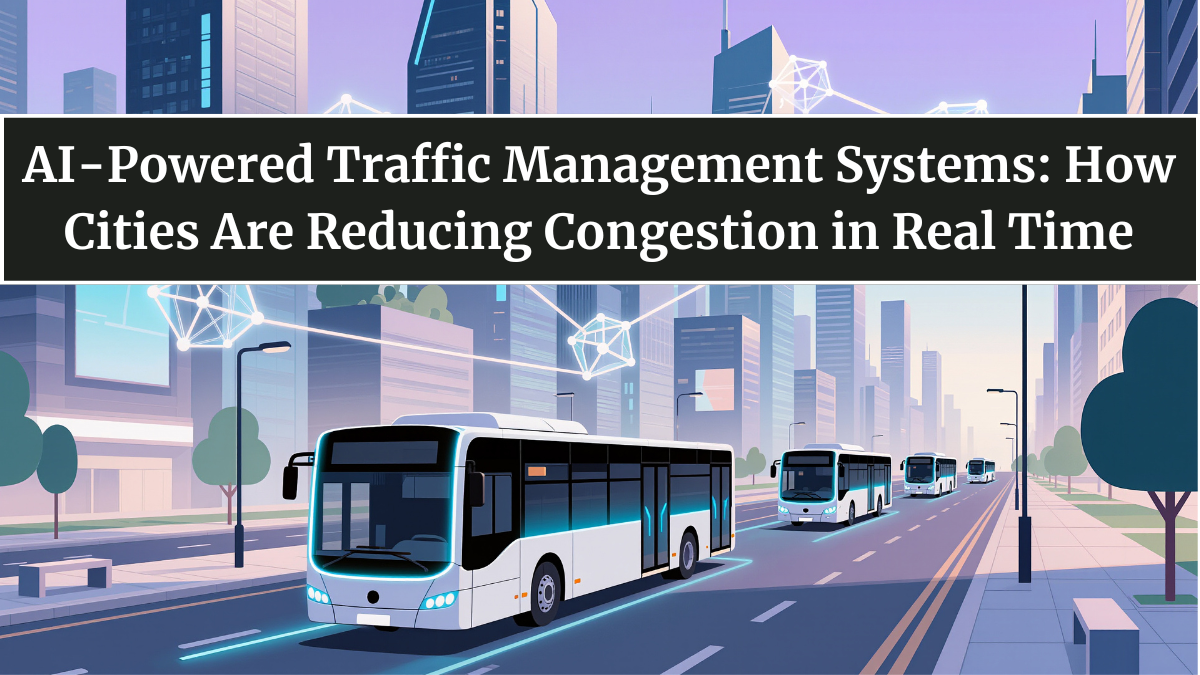Imagine traffic lights that think for themselves, sensors that predict jams before they happen, and AI algorithms that adjust entire city routes in real time. This is not science fiction — it’s AI-powered traffic management, the backbone of next-generation smart cities.
In 2025, urban congestion has reached unprecedented levels, pushing city planners and technologists to rethink mobility from the ground up. Artificial intelligence is leading the way, transforming traditional, reactive traffic control into dynamic, self-learning systems that cut travel time, save fuel, and reduce emissions.

Why AI Traffic Systems Are the Future
Conventional traffic lights work on timers — they don’t adapt when roads get crowded. AI-driven traffic systems, however, do much more. They use data from cameras, sensors, GPS, and connected vehicles to detect patterns and respond instantly to changing road conditions.
These systems continuously learn from live data, adjusting signal timings, rerouting vehicles, and even prioritizing ambulances or public transport. Cities adopting these systems are reporting up to 25–40% reductions in average waiting time and significant improvements in overall traffic flow.
How AI Improves Real-Time Traffic Flow
Modern AI traffic systems combine machine learning, edge computing, and predictive analytics to monitor, analyze, and control vehicle movement at every second.
Key functions include:
-
Adaptive Traffic Lights: Automatically adjust timing based on vehicle density.
-
Incident Prediction: AI can forecast congestion and reroute traffic before it occurs.
-
Emergency Vehicle Prioritization: Detects approaching ambulances or fire trucks and clears lanes automatically.
-
Public Transport Integration: Syncs buses and metro arrivals with traffic lights for smoother scheduling.
The result is a smarter, faster, and cleaner traffic network that grows more efficient with every data cycle.
Global Cities Leading the AI Mobility Revolution
Cities around the world are embracing AI to enhance road efficiency:
-
Singapore has integrated predictive AI algorithms across its Smart Nation initiative, reducing citywide delays during peak hours.
-
London uses AI-driven adaptive signals that optimize over 3,000 intersections daily.
-
Los Angeles has deployed real-time monitoring networks that automatically recalibrate traffic based on camera and weather data.
-
Bengaluru and Pune in India are testing AI-assisted control centers capable of managing vehicle flows across multiple corridors simultaneously.
Each project proves one thing — AI traffic management is no longer optional; it’s essential for sustainable urban living.
Environmental and Economic Impact
AI doesn’t just ease congestion — it makes cities greener. Reduced idling leads to lower emissions, while efficient traffic flow saves millions of liters of fuel annually.
Environmental benefits include:
-
20–30% lower CO₂ output from vehicles.
-
Significant reductions in noise pollution.
-
Optimized integration with electric and shared mobility fleets.
Economically, governments save on infrastructure expansion since smarter roads mean fewer new roads needed. AI-based systems extend the lifespan of existing networks through better utilization.
Challenges in Implementing AI Traffic Systems
While the benefits are undeniable, several challenges slow full-scale deployment:
-
Data Privacy Concerns: Continuous surveillance can raise public apprehension.
-
Infrastructure Gaps: Many developing cities lack uniform digital networks or IoT sensors.
-
Algorithm Bias: Poorly trained AI systems may misjudge traffic priorities.
-
Cost and Maintenance: Building and maintaining high-tech systems requires significant investment.
To overcome these, governments are focusing on public-private partnerships, open-data policies, and local innovation ecosystems.
The Road Ahead: Traffic 2030
By 2030, AI traffic management systems will become fully autonomous, operating as central nervous systems of smart cities. Trends shaping this future include:
-
Integration with autonomous vehicles and EV fleets.
-
Predictive urban planning, using traffic simulations before constructing roads.
-
AI coordination across public transport, logistics, and private vehicles.
-
Sustainability-first design, where emissions, not just time, determine route optimization.
The next decade will see traffic lights evolve from mere signal posts to intelligent urban nodes — communicating, learning, and orchestrating movement like never before.
FAQs
What is AI-powered traffic management?
It’s an intelligent traffic system that uses artificial intelligence and data analytics to monitor, predict, and control vehicle flow in real time.
How does AI reduce congestion?
AI systems analyze live data from cameras and sensors to predict jams, optimize signals, and reroute vehicles dynamically.
Which countries are leading in AI traffic technology?
Singapore, the UK, the USA, and India are among the leaders deploying adaptive, real-time traffic management solutions.
What are the environmental benefits?
Smarter traffic flow means reduced idling, lower CO₂ emissions, and improved fuel efficiency across cities.
What’s next for traffic systems?
Future systems will integrate autonomous cars, public transport, and predictive analytics into a unified smart-city mobility network.
Click here to know more.
